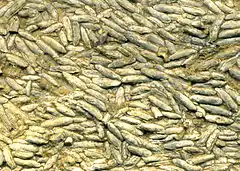| Kansas City Group/Formation | |
|---|---|
| Stratigraphic range: | |
 Fossils from the Iola Formation, Kansas City Group | |
| Type | Group/Formation |
| Unit of | Missourian Stage |
| Sub-units | Kansas Classification:[1] Bonner Springs Shale Wyandotte Limestone Lane Shale Iola Limestone Chanute Shale (sandy) Drum Limestone (cherty) Cherryvale Shale (cherty) Dennis Limestone (cherty) Galesburg Shale (sandy) Swope Limestone Ladore Shale Hertha Limestone |
| Underlies | Lansing Group |
| Overlies | Pleasanton Group |
| Lithology | |
| Primary | Cherty limestone, shale, sandstone |
| Other | coal |
| Location | |
| Region | Midcontinent Seaway |
| Country | United States |
| Type section | |
| Named for | Kansas City, Missouri |
| Named by | J. A. Gallager [2] |
| Year defined | 1898 |
Kansas City is a Late Carboniferous geologic group and formation having various significant alternating beds of limestone and shale known for forming high bluffs in Missouri, Kansas, and neighboring states. This formation was named for the bluffs within Kansas City, Missouri.[3] Primary group outcrops are in northwest Missouri. This group has been a historic oil producing unit within the state of Kansas.[4]
See also
References
- ↑ Classification of Rocks in Kansas (Kansas Stratigraphic Chart), Kansas Geological Survey, 2018, retrieved 2023-11-22
- ↑ Lexicon of Geologic Names of the United States: (including Alaska). United States Department of the Interior. 1938. p. 1070. Retrieved 2023-11-22.
- ↑ "Geologic Unit: Kansas City". National Geologic Database. Geolex — Unit Summary. United States Geological Survey. Retrieved 2023-11-22.
- ↑ D.L. Baars, W. Lynn Watney, Don W. Steeples, and Erling A. Brostuen (1993). "Petroleum: a primer for Kansas". Educational Series (7): 9. Retrieved 2023-10-24.
{{cite journal}}: CS1 maint: multiple names: authors list (link)
This article is issued from Wikipedia. The text is licensed under Creative Commons - Attribution - Sharealike. Additional terms may apply for the media files.